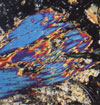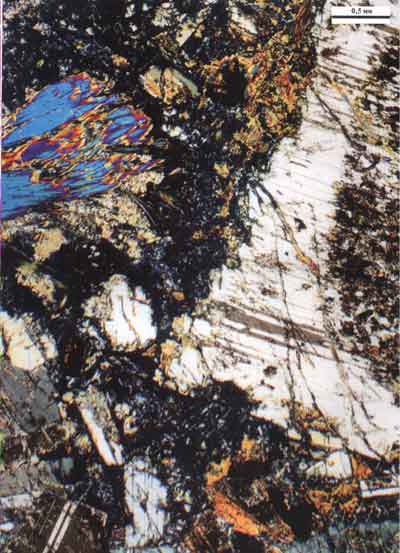 |
There
is plenty of amphibole
in the Siberian Traps |
Alexei
V. Ivanov
Institute
of the Earth’s Crust, Siberian Branch, Russian
Academy of Sciences, Irkutsk, Russia
aivanov@crust.irk.ru
Like most scientists,
we have time to read only the titles of papers we
cite (Vogt
& Holden, 2007, p. 961).
Introduction
The Siberian Traps, like many other flood basalt provinces,
is characterized by large volumes of low-Ti basalts
and intrusions. All low-Ti rock types and some high-Ti
rock types are depleted in high field strength elements,
making them similar to subduction-related arc basalts
(e.g., Puffer, 2001). The conventional
explanation for this is crustal contamination of a
primary “dry” sublithospheric melt (i.e.,
a plume, e.g., Lightfoot et al., 1993; Wooden
et al., 1993; Reichow et al., 2005).
As an alternative Puffer (2001) and Ivanov & Balyshev (2005)
argued for a “wet” mantle source resembling
the source of arc basalts. Puffer (2001) assumed
a subcontinental lithospheric mantle source, modified
by subduction processes that occurred long before Siberian
Trap magmatism. Ivanov & Balyshev (2005)
suggested a link between Permian subduction and this “wet” mantle
source (for the latest references for this idea see Ivanov,
2007 and Ivanov et al., in press). The idea
received various formal and informal critiques, including
one particularly important criticism, which was mentioned
by several people. That criticism amounts to:
“Wet magmas in arcs evolve through fractional
crystallisation of amphibole-bearing assemblages.
Why didn't amphibole crystallise from the Siberian
magmas?”
The fact is, amphibole did crystallise
from the Siberian Trap magmas. This information is
widely available but has been overlooked (including
in my own earlier publications). This webpage summarises
the information on primary magmatic water-bearing minerals
in the Siberian Traps.
Amphibole in arcs
Caveat: The Siberian Traps province
contains mainly basaltic lavas and mafic intrusions
(basalts sensu lato). More silica-rich rocks are present
in minor amounts. In arc systems, basaltic magmas are
important, but their volume is comparable to that of
andesitic magmas. In this webpage I compare amphibole
occurrences in the Siberian Traps and arcs, but my
comparison is restricted to basaltic rocks. I thank
several readers of an earlier version of this webpage
for pointing out that amphibole occurs quite commonly
in arc andesites.
Amphibole is quite
a rare mineral in arcs worldwide (Bob Stern, personal
communication). For example, in Kamchatka where continental
arc formed above the subducting Pacific slab, amphibole-bearing
rocks have often been found together with mica-bearing
rocks in intrusions and volcanic bombs (which might
also be fragmented subvolcanic intrusions). This amphibole
and mica occur in fault systems perpendicular to the
frontal arc – the
Aleut-Kamchatka and Malko-Petropavlovsk fault systems.
Amphibole and mica-bearing rocks are represented by
moderate- and high-alkaline basic rocks (Perepelov
et al., 1986; Melekestsev et al., 1991; Volynets
et al., 1997). In the rear volcanic arc of the
Kamchatka system, amphibole has only been found in
high-K shoshonitic basalts (Melekestsev et al.,
1991). Low-K intrusive and effusive rocks don’t
contain amphibole in the Kamchatka arc system to my
knowledge. It is worth mentioning that the Siberian
Trap rocks are mainly low-K.
Amphibole and mica in the Siberian
Traps
The most recent and comprehensive information on the
petrography of rocks and geology in the Siberian Traps
near Noril’sk was published by Ryabov et
al. (2001a, 2001b). This work is particularly
useful because it comprises a complete petrographic
documentation (whole-rock and mineral microprobe chemical
analyses plus colour photographs of thin sections)
of all effusive formations and all intrusive complexes
mapped in the Noril’sk region (Ryabov et
al., 2001b). Table 1 is a compilation of this
information for the intrusive complexes. There is no
amphibole and mica in effusive rocks, which is not
surprising since arc effusive rocks do not contain
amphibole or mica either.
“Wet” assemblage (Table
1) signifies that the rock contains primary magmatic
water-bearing minerals, either amphibole, biotite,
phlogopite or combination of these minerals. “Dry” assemblage
signifies the absence of these minerals in a rock.
The quantity of the “dry” samples is an
upper estimate, because many contain secondary minerals
such as chlorite, which could have developed from primary
magmatic mica.
Table 1: Water-bearing minerals
in intrusive complexes of the Noril’sk region.
Figures show number of described samples (compiled
after Ryabov et al., 2001b).
Intrusive complex
(older to younger) |
Rock type |
Mineral
assemblage |
“Dry” |
“Wet” |
|
Amph |
Bt |
Phl |
Amph
and/or Bt and/or Phl |
Ergalakh |
B |
11 |
- |
- |
- |
- |
Pyasino |
B |
- |
1 |
- |
- |
- |
Gudchikha |
U-B |
1 |
- |
- |
1 |
- |
Ogoner |
B |
- |
- |
6 |
- |
1 |
Fokina |
U-B |
5 |
- |
- |
1 |
1 |
Noril’sk: Noril’sk
type |
B,
U |
25 |
3 |
3 |
14 |
9 |
Noril’sk: Upper-Talnakh
type |
B |
- |
1 |
1 |
7 |
- |
Noril’sk: Kruglaya
Mt. type |
B |
3 |
1 |
5 |
1 |
- |
Noril’sk: Zub
type |
B,
U-B |
2 |
- |
1 |
4 |
- |
Morongo |
B |
8 |
- |
4 |
2 |
- |
Daldykan |
B |
5 |
1 |
3 |
- |
- |
Dzhaltul |
B |
7 |
1 |
5 |
1 |
3 |
Avam |
B |
4 |
- |
5 |
- |
- |
Lamprophyre |
L |
- |
- |
- |
1 |
- |
Bolgokhtokh |
GD |
- |
- |
- |
- |
1 |
Rock-types: B–basic, U–ultrabasic (picrites),
U-B–transitional between basic and ultrabasic
(e.g. picritic basalts), L–various types of lamprophyric
rocks, GD–granodiorites.
Ergalakh is Late Permian
complex by geologic data. Noril’sk
is the Permian-Triassic boundary complex (Renne,
1995; Kamo et al., 2003). Daldykan and Avam
are Middle Triassic complexes (Dalrymple et al.,
1995). Bolgokhtokh is Late Triassic (Dalrymple
et al., 1995; Kamo et al., 2003). Total
duration of magmatism was about 22-26 Ma (see Ivanov
et al.,
2005; Ivanov, 2007).
It could be seen that that all the
intrusive complexes except Ergalakh contain “wet” mineral
assemblages (Table 1). Moreover, the “wet” mineral
assemblages are dominant when compared with the “dry” mineral
assemblages. Phlogopite is the most common mineral
among primary magmatic water-bearing minerals. Amphibole
(either alone or in combination with mica) was found
in about 12% of samples of intrusive rocks listed by Ryabov
et al. (2001b). An example of amphibole-bearing
gabbro from the Upper-Talnakh type of Noril’sk
complex is shown in Figure 1.

Figure 1: Thin section of leucocratic
gabbro (sample KZ-1684/1986,0) from the Upper-Talnakh
type intrusion. Crossed nicols. Margin of a large
plagioclase prism dominates the image. Matrix is
composed of plagioclase (white and grey), clinopyroxene
(brown), amphibole (blue) and ilmenite within palagonite
(black). Reproduced from Ryabov et al. (2001b, p.
241).
Beyond the Noril’sk region, mica was reported
in meimechites from Maymecha-Kotuy province (Fedorenko & Czamanske,
1997), gabbros from the West Siberian Basin (Reichow
et al., 2002) and dolerites of the Angara-Taseevskaya
syncline (Ivanov, 2007; see Figure 2 for locations).
Amphibole is probably present in the intrusive rocks
of these regions too, but since it is rarer than mica,
and nobody has yet searched for it. If a search were
made, it might be found.

Figure 2: Siberian Traps (modified from Masaitis,
1983). WSB – West Siberian Basin, ATB – Angara-Taseevskaya
syncline, N – Noril’sk, MK – Maymecha-Kotuy.
Summary
Primary magmatic minerals (amphibole and mica) are
common in the intrusive rocks of the Noril’sk
region. Primary magmatic mica has also been reported
from other regions of the Siberian Traps. This supports “wet” source
models for the Siberian Traps.
References
-
Dalrymple, G.B., Czamanske,
G.K., Fedorenko, V.A., Simonov, O.N., Lanphere,
M.A., and Likhachev, A.P., 1995. A reconnaissance 40Ar/39Ar
study of ore-bearing and related rocks, Siberian
Russia. Geochim.
Cosmochim. Acta. 59, 2071-2083.
-
Fedorenko,
V.I., Czamanske, G.K., 1997. Results of new filed
and geochemical studies of the volcanic and intrusive
rocks of the Maymecha-Kotuy area, Siberian flood-basalt
province, Russia. Int. Geol. Rev. 39, 479-531.
-
Ivanov,
A.V., 2007. Evaluation of different models for the
origin of the Siberian Traps. In: The origin
of melting anomalies: Plates, plumes and planetary
processes; (eds) Foulger G R and Jurdy D M
(Princeton: Geological Society of America Special
Paper), 669-692.
-
Ivanov, A.V., Demonterova, E.I., Rasskazov,
S.V., Yasnygina, T.A., in press. Low-Ti melts from
the Southeastern Siberian Traps Large Igneous Province:
Evidence for a water-rich mantle source? J. Earth
System Sci.
-
Ivanov, A.V., Balyshev, S.V., 2005.
Mass flux across the lower-upper mantle boundary: vigorous,
absent, or limited?; In: Plates, plumes and paradigms;
(eds) Foulger G R et al (Princeton: Geological
Society of America Special Paper 388) 327-346.
-
Ivanov,
A.V., Rasskazov, S.V., Feoktistov, G.D., He, H.,
Boven, A., 2005. 40Ar/39Ar dating of Usol’skii
sill in the southeastern Siberian Traps Large Igneous
Province: evidence for long-lived magmatism. Terra
Nova 17, 203-208
-
Kamo, S.L., Czamanske,
G.K., Amelin, Yu., Fedorenko, V.A., Davis, D.W.,
Trofimov, V.R., 2003. Rapid eruption of Siberian
flood-volcanic rocks and evidence for coincidence
with the Permian-Triassic boundary and mass extinction
at 251 Ma. Earth Planet.
Sci. Lett. 214,
75-91.
-
Lightfoot, P.C., Hawkesworth,
C.J., Hergt, J., Naldrett, A.J., Gorbachev, N.S.,
Fedorenko, V.A., Doherty, W., 1993. Remobilisation
of the continental lithosphere by a mantle plume:
major-, trace-element, and Sr-, Nf-, and Pb-isotope
evidence from picritic and tholeitic lavas of the
Noril’sk District,
Siberian Trap, Russia. Contrib. Mineral. Petrol. 114,
171-188.
-
Masaitis, V.L., 1983. Permian and
Triassic volcanism of Siberia. Zapiski Vserossiiskogo
Mineralogicheskogo Obshestva 4,
412-425. (In Russian)
-
Melekestsev, I.V., Volynets, O.N.,
Ermakov, V.A., Kirsanova, T.P., Masurenkov, Yu.P.,
1991. The Shiveluch volcano. Active
volcanoes of Kamchatka, v. 1 (Moscow: Nauka)
84-103. (In Russian)
-
Perepelov, A.B., Bazanova, L.I.,
Florensky, I.V., Baluev, E.Yu., 1986. Geochemical
evolution of the Late Cenozoic magmatism
of the southeastern flank of the Malko-Petropavlovsk
zone of the cross-cut fault dislocations (Kamchatka).
In: Geochemistry of magmatic rocks from different
geodynamic settings (Novosibirsk: Nauka) 165-179.
(In Russian)
-
Puffer, J.H., 2001. Contrasting high-filed strength
element content of continental flood basalts from
plume versus reactivated-arc sources. Geology, 29,
675-678.
-
Reichow, M.K., Saunders, A.D., White,
R.V., Pringle, M.S., Al'mukhamedov, A.I., Medvedev,
A.I., Kirda, N.P., 2002. 40Ar/39Ar dates from the
West Siberian Basin: Siberian flood basalt province
doubled. Science 296,
1846-1849.
-
Reichow, M.K., Saunders, A.D.,
White, R.V., Al’mukhamedov,
A.I., Medvedev, A.Ya., 2005. Geochemistry and petrogenesis
ob basalts from the West Siberian Basin: an extension
of the Permo-Triassic Traps, Russia. Lithos 79,
425-452.
-
Renne, P.R., 1995. Excess 40Ar
in biotite and hornblende from the Norilsk 1 intrusion,
Siberia: implication for the age of Siberian Traps. Earth
Planet. Sci. Lett. 131,
165-176.
-
Ryabov,
V.V., Shevko, A.Ya., Gora, M.P., 2001a. Magmatic
formations in Noril’sk region. Volume 1.
Trapp petrology. (Novosibirsk: Nonparel
Publishers) (In Russian).
-
Ryabov, V.V., Shevko,
A.Ya., Gora, M.P., 2001b. Magmatic
formations in Noril’sk region. Volume 2.
Atlas for magmatic rocks. (Novosibirsk:
Nonparel Publishers) (In Russian).
-
Vogt, P.R. & Holden, J.C.
Plumacy reprise. In: Plates,
plumes and planetary processes, Eds. Foulger
G.R. and Jurdy D.M., Geological Society of America
Special Paper 430, 955-974.
-
Volynets, O.N., Ponomareva, V.V.,
Babansky, A.D., 1997. Magnesian basalts of Shiveluch
andesite volcano, Kamchatka. Petrology 5, 183-196.
-
Wooden,
J.L., Czamanske, G.K., Fedorenko, V.A., Arndt,
N.T., Chauvel, C., Bouse, R., M., King, B.-S.W.,
Knight, R.J., Siems, D.F., 1993. Isotopic and trace-element
constraints on mantle and crustal contributions
to characterization of Siberian continental flood
basalts, Noril’sk area, Siberia. Geochim. Cosmochim.
Acta 57, 3677-3704.
last updated 31st
January, 2008 |
